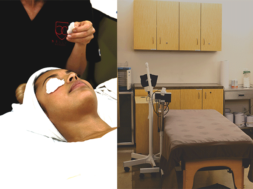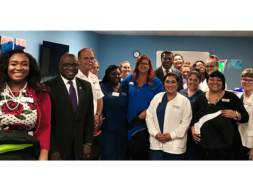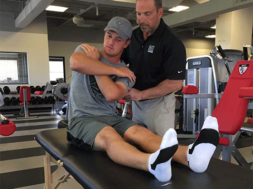
By Larry Banks, Ph.D., Director, Competency Based Education Services, Wonderlic, Inc.
Harvard Business professor and award-winning author on leadership and change, John Kotter tells a story about a penguin colony that lived on the same iceberg for years. One curious bird discovers that the iceberg is melting, but few of his fellow penguins want to heed his warnings that they must react to the melting iceberg. The penguins are fine with the way things have always been done and see no need to change. In the education sector, “melting icebergs” are akin to aging programs that are becoming irrelevant. Some schools and services are decreasing in quality, due to their adherence to strategies that no longer make sense in today’s knowledge economy. If these schools and services refuse to react to this decrease – or “melting,” if you will – then they will be left out to sea in the cold icy waters of irrelevance. Thus, Kotter’s story is analogous to what is currently going on within the career college sector. Our iceberg is shrinking on all sides, and we must decide how we are going to react.
Without a doubt, 2014 was a challenging year for our sector. Enrollments continue to decline and an unprecedented increase in for-profit oversight both at the Federal and State level is one way our iceberg is melting. Heightened attention to the issues of affordability and gainful employment are other examples of problems threatening our iceberg. Now, more than ever, career schools need to clearly demonstrate outcomes if they want to thrive in this new political climate. In Kotter’s story, once the penguins came to understand that their iceberg actually was melting, they: 1) created a sense of urgency to deal with the difficult problem; 2) put a carefully selected group in charge of guiding the change; and 3) found the sensible vision of a better future. With that said, a sensible vision of the future for members of the career college sector seems to be that of focusing on aligning outcomes with employer required competencies. According to higher education research and advisory firm Eduventures, “We will continue to see an emphasis on outcomes in conversations among parents and the government.”
To address the continuing concerns regarding the value of a career education, institutions should demonstrate that they teach to outcomes that matter for employability.
Eduventures has reported that “Higher education should expect to see schools becoming more aggressive in how they differentiate themselves in reporting their specific outcomes.”
It seems that we read something on a daily basis about how competency-based education is disrupting higher education. There are countless CBE advocates who are positive that this approach to education may help us survive our shrinking iceberg. Yet, despite the backing of powerful supporters, career colleges have been reluctant to go all-in because they are unsure whether accreditors and the Department of Education will approve their proposed CBL programs.1 Moreover, many career school educators strongly believe that their learning models have always been competency-based and in the case of some programs, they actually are. Others within our sector think that competency-based learning is a passing fad. They say 2013 was the year of the MOOC and 2014 was the year of competency-based education. At present, there are more than a hundred competency-based programs poised to launch in 2015. Eduventure suggests some of those programs “will be designed around the principles and practices of direct assessment, but, that won’t become the norm.” Rather, schools launching competency-based learning models will mirror the competency model proven by Western Governors University. WGU programs are designed by a “council” of experts who define what competencies graduates should possess, administer independent assessments to verify, and mentor students for completion (Schaffhauser, 2015).
Always been competency based
In truth, CBL is not as new as it might appear. Dr. Pamela Northrup from the University of West Florida’s Innovation Institute commented, “Competency-based learning is just excellent instructional design.” The question is whether to follow suit and adapt, or remain staunch advocates of the teachings of yesterday” (Williams, SkilledUp). To put it in the context of Kotter’s story, the question is whether we will admit our iceberg is melting and develop an appropriate response.
There is plenty of evidence that shows CBL works. CBL forces faculty and employers to engage in difficult discussions on competencies and outcomes that matter.
In higher education, the concept of competency was originally used to describe trainee teacher behaviors (Bowdenard Masters, 1993; Hoffmann, 1999). Competency is a person-related concept, competence is a work related concept. According to Kouwenhoven (2003), “Competency is the capability to choose and apply an integrated combination of knowledge, skills, and attitudes with the intention to realize a task. A way to conceptualize the relation between education and the workplace is through competency-based education. If specific competencies are not focused and aligned in the curriculum, the products of the higher education may not be “work-ready” and therefore not readily accepted by the industry. Therefore, to reduce unemployment and ‘under employment’ levels, it becomes necessary to consider ‘occupation-specific competencies’ in the curriculum designs (Sudsomboon, 2007).
The characteristics of competency-based education (CBE) as given by Kouwenhoven (2003) are as follows:
- CBE is learner-centered and the learning process is central
- The role of the teacher is that of a cognitive guide
- The learning environment is focused on the development of competencies
- Assessment is focused on competencies
- Curriculum development is based on the elaboration and identification of competencies
According to the Accrediting Council for Independent Colleges and Schools:
A competency-based program is one that utilizes a robust curriculum development process, in collaboration with employers and other stakeholders. It clearly defines the skills, knowledge and values (soft skills) that are required for a student or a graduate to perform at a level considered to be competent by practitioners and employers in the field. It focuses on direct, not indirect, assessment methods to measure student learning. Indirect assessment of student learning, while deemed valuable for institutional program evaluation and enhancement, are not included in the consideration for approval of a competency-based program
In addition, Brownell and Chung (2001) have identified five major benefits of competency-based education: “A change in the student-teacher relationship; an increase in emphasis on internal information sharing; improvement in clarity of desired student outcomes and program effectiveness; better articulation of the competencies of program graduates; and, an increase in student satisfaction and learning.”
There is no need for big changes in your programs. However, there is a need to align your outcomes with employer vetted competencies. Why would you not want to align course and program outcomes to competencies that matter for employability? Recently, I spoke to Chancellor A. R. Sullivan of Sullivan University. He said it best, “All you are doing with CBL is helping schools to do what we do a little better.” At the Accrediting Commission of Career Schools and Colleges annual conference, Dr. Michael McComis said, “We have always been competency based.” But have we? I suggest that we have, but generally, schools in our sector have not been able to provide evidence of mastery of aligned employer competencies. In my experience, I have noticed that many schools in our sector often confuse the term “learning objective” with the term “learning outcome” even though they have very different meanings. Moreover, the learning objectives are often not well written.
According to a U.S. Department of Education report2, the importance of implementing competency-based initiatives in colleges and universities lies in two major reasons: a) Specific articulations of competencies inform and guide the basis of subsequent assessments at the course, program, and institutional levels. b) Specific competencies help faculty and students as well as other stakeholders such as employers and policymakers, to have a common understanding about the specific skills and knowledge those undergraduates should master as a result of their learning experiences.
Institutional nervousness about competency-based education is understandable. The perception that faculty are not important to the instructional process, and trying to prove what students know through assessment is controversial – even when it is backed by sound measurements of college-level learning. But I can attest from my experience as a prior administrator of competency-based programs that not all competency-based learning models are self-paced, correspondence programs on steroids. Based on my experience and in field research, competency-based learning models (in one form or another) have three tenets:
- Independent and secure assessment
- Mentoring/coaching students for completion
- Credit for learning, no matter how, where or when knowledge is learned
How an institution structures its competency-based learning model may include faculty as mentors and coaches, independent assessment can be used to personalize the learning experience and competency-based learning can be tied to quarters or semesters to avoid Title IV issues.
A competency-based learning model helps the institution to demonstration consistency, continuity, and evidence that the institution is focused on outcomes that matter.
From a federal perspective, the tension over competency-based education is about protecting financial aid dollars. The Feds want to make sure the money is flowing to colleges that offer degrees of value, which are tied to solid learning outcomes.3
A program that is organized by competency, but measures student progress using clock or credit hours, is a CBE program, but not a direct assessment program. In such a program, Title IV aid must be administered under normal statutory and regulatory provisions for clock or credit hour programs. A direct assessment program is another form of CBE program. Student progress in a direct assessment program is measured solely by assessing whether the student can demonstrate that he or she has a command of a content area. The credit hour is still higher education’s gold standard, even after President Obama’s vague endorsement last month of competency-based education and its focus on “performance and results” rather than seat time (Fain, 2013). All but a few DoE approved competency-based programs are grounded in the credit hour. Often the terms, “competency-based” programs and “direct assessment” programs are used interchangeably in articles, training sessions and even Department guidance documents. Therefore, the terms are confusing and misunderstood. Direct assessment programs are a subset of the larger, more diverse category of academic programs that qualify as “competency-based.”
Refresh your programs by aligning outcomes with employer vetted competencies
There are the innovators and the early adopters. On your campuses there are faculty and staff that will be willing to take risks for the greater good. Gather them together and give them the resources, the authority and the latitude to refresh your programs. Consider implementing a competency-based learning model. This means, independent assessment for quality assurance and validity. This means, using the data to mentor students for success, and using the data to improve learning experiences. This means, changing the culture to be outcomes driven. That said, a cultural shift along with rules and regulations of your school may prohibit innovation needed to implement a competency-based curriculum.
A major challenge for faculty and administrators will be the “data ramifications” that ensure that competencies are both valid and reliable. Engaging faculty to develop and implement competency-based learning is not for the faint of heart. Institutional effectiveness personnel have been reluctant to get involved with direct measures of student learning. Culture dictates that such measures belong to program leaders and faculty. The traditions and rules of “academic freedom” somehow demand this. The problem is that faculty and program leaders are indeed content experts, but they are no more versed in effective assessment of student outcomes than anyone else on campus. Do not continue to collect surveys that tell you that your students are happy – instead ask for assessment data that shows the quality of learning and what students know.
Demonstrate your school’s value by proactively providing reports on how your instructional process is meeting the needs of its stakeholders. If there is to be change in the current culture, you have the power to make it happen. Refreshing your programs to be current and relevant with measurable outcomes is not a “disruption,” it is an imperative! It is up to you to change the conversation from GPAs and satisfaction surveys. Collect the evidence that students are learning what they need to know to improve their probability of placement within their field of study. One of the important themes at EDUCAUSE 2014 is the growing use of analytics in education. A useful metaphor for student learning analytics can be physician diagnostic tools: both student learning analytics and physician diagnostic tools provide a diagnosis for a problem and can provide the opportunity to recommend a cure. Analytics can be used to inform: evidence of quality; pinpoint improvement areas; and, to mentor students for program completion.
Assessment renaissance
For years, the primary source of evidence for a positive impact of instruction has come from course evaluation surveys. Institutional research personnel combine and correlate the data with other indirect measures such as retention, enrollment and grade point averages. Campus wide assessment efforts rarely involve assessment of actual student learning that is aligned with employer vetted competencies. All of this is called “institutional assessment,” but this does not produce the statistical evidence that demonstrates the school is directly responsible for students’ mastery of course outcomes or competencies. With technology and a little thought, your school can demonstrably prove that a change in student learning is statistically significant over time and is the result of soundly delivered curriculum. This is the kind of “assessment” that matters. Given the cost and negative press, career schools need to provide evidence that an education at their school leads to mastery of competencies that matter for employability. Accreditors currently rely on indirect outcome measures. With that said, indirect measures no longer suffice and the public wants evidence that what is being taught is useful and needed to enter a profession.
Over one year ago, the Daymar College Group refreshed and renewed the Medical Assisting program at all of its campus by developing its competency-based learning model in phases. The heart and soul of all competency-based education models is assessment and mentoring of students for completion. Phase one aligned curriculum with employer vetted competencies and introduced the idea of mentoring for student success. Daymar collaborated with Wonderlic to align its program curriculum with employer vetted competencies, and engaged Wonderlic to administer independent assessments that measure mastery of competencies. Daymar’s campus wide assessment efforts measures actual student learning outcomes that are aligned with employer vetted competencies. Its ComBase program4 is an example of refreshing and improving programs by carefully aligning learning objectives and outcomes to competencies that matter to employers. Academic committees used Wonderlic’s rank-ordered, employer-vetted competencies, advisory boards, faculty and local employer data to carefully describe learning objectives. Using Wonderlic’s direct assessment technology (DALO), Daymar’s CompBase programs independently assess students for mastery of competencies. The data from student assessments is used to mentor students for success and to ensure program quality and continuity throughout all campus locations.
Daymar’s CBL model does not deviate from the standard quarter system. Currently, for career schools, phase 2 – self-paced learning, detached from time is problematic. It is worth noting that a number of community colleges are implementing and developing competency-based education models similar to Daymars’ – independent assessment and mentoring or coaching students for success.
Daymar uses assessment data to inform and improve its programs. For example, system wide, students struggled with dosage calculation in a pharmacology course. As a result, faculty focused their instruction and additional learning resources were added to aid students in learning how to calculate dosage – a core competency in Pharmacology. The table below shows averages from two separate cohorts: academic term 2 and academic term 3.
| Pharmacology | Term 3 Average | Term 2 Average |
| Forms of Administration | 77% | 76% |
| Dosage Calculations | 59% | 58% |
| Pharmacology Dosage | 64% | 63% |
| General Pharmacology and Abbreviations | 77% | 76% |
Program Directors learned that many students in the Criminal Justice program do not understand the concept of “hearsay” in the Rules of Evidence course. Students in an Anatomy course were having trouble understanding nervous systems. As a result, Program Directors selected a different learning resource. Assessment data provides evidence of learning and reveals areas that need improvement.
Program Directors at Daymar are called Program Mentors. Program Mentors meet with students to review student mastery of competencies. The process of using assessment data to mentor students reduced monthly withdrawals by an average of 2 percent. At first, faculty and program directors were reluctant to change and they were to say the least concerned about the notion of an independent assessment to measure learning and mastery of competencies. Implementing competency-based learning is a cultural change – a shift to “it is about learning and demonstrating that you know, what you need to know.” In that way, competency-based learning disrupts. You will find that the majority of your faculty will embrace competency-based learning. Like any academic cultural shift, take the time to talk to all stakeholders and make sure you get faculty buy-in. Bowen and Tobin cite the demise of the Global Campus initiative at the University of Illinois as an example of how an initiative proposed by administrators can fail “if faculty harbor doubts about its academic value.5”
Independent assessment data are used to improve student learning, validate and to ensure quality programing. At Daymar, a student does not have to re-take a course if they fail to master the competencies. Instead, when they learn that they are having trouble with a specific competency, they can keep working on it until they have nailed it. They do this with the guidance of faculty mentors who coach them through the entire course.
Closing thoughts
Is competency-based education a disrupter? Have career school programs always been competency-based? I do not think competency-based learning has to disrupt, and while many career school programs are competency-based, they do not use assessment data effectively. The most effective competency-based programs are those that use assessment data for quality assurance and as a tool to help the faculty mentor their students for successful program completion. Rather, schools rely on student and employer satisfaction surveys which are not good statistical indicators of student achievement of program and course outcomes. Overall, colleges and universities need to do a better job of providing evidence that their students know what they need to know to get the job. Evidence of student mastery of employer vetted competencies is one way to squelch the for-profit, career school naysayers. Colleges and universities should consider refreshing their programs to incorporate competency-based learning – in one form or another. Why? We all need to do a better job of demonstrating “learning” outcomes – the future of our sector may well depend upon it.
Competency-based learning can be implemented in phases and schools in the for-profit sector can start by refreshing existing programs. By refreshing and improving its existing programs, Daymar’s retention improved because students are being mentored for success, and they are able to see the value of learning competencies that matter for employability. Rasmussen is taking a different approach to competency-based learning. Its hybrid approach allows students to study general education courses in a self-paced manner at no charge. The core courses of their competency-based program are taught and tied to time in the traditional manner. Various community colleges have introduced competency-based programs that are not self-paced. Instead, the programs are linked to time and they are both faculty and assessment driven.
Currently, many faculty and administrators believe that there is no need to change their instructional models. That is like saying, “The penguins are fine with the way things are done and they see no need to change.” Career schools are closing, losing enrollment and their value is being questioned. Therefore, our “iceberg appears to be melting” because of aging and irrelevant programs, courses, and teaching that is stuck in the 20th century. In the 21st century, competency-based education in one learning model or another, combined with dynamic learning resources and technology is here to stay. Jan Gordon (Spencerian College) told me about a conversation she had with one of her graduates. The graduate said, “Tuition is expensive, but a career is priceless.” Competency-based learning models will help our sector to provide evidence that we do indeed prepare and mentor students for honorable careers.
1 Fain, Paul. “A Disruption Grows.” Inside Higher Education, Oct 1, 2012.
2 U.S. Department of Education, National Center for Education Statistics. Defining and Assessing Learning: Exploring Competency-Based Initiatives, NCES 2002-159, prepared by Elizabeth A. Jones and Richard A. Voorhees, with Karen Paulson, for the Council of the National Postsecondary Education Cooperative Working Group on
Competency-Based Initiatives. Washington, DC: 2002.
3 Fain, Paul. “A Disruption Grows.” Inside Higher Education, Oct 1, 2012.
4 http://www.daymarcollege.edu/about-us/what-competency-based-learning
5 Kolowich, Steve. “What Doomed Global Campus.” Inside Higher Education, Sept. 3, 2009.

Dr. Larry Banks, is the Director of Competency Based Education Services, Wonderlic, Inc. Previously, he was Provost and Vice President of operations for the Daymar Colleges Group, which includes 35 career tracks and 16 campuses in Tennessee, Ohio, and Kentucky, as well as online degree programs. Banks was Associate Provost at Western Governors University; Provost at Rocky Mountain University of Health Professions; and Vice President of Academics at Eagle Gate College. Dr. Banks specializes in retention and learning strategies. He earned his doctorate degree in Business Administration from Touro University International.
Contact Information: Larry Banks, Ph.D. // Director of Competency Based Education Services // Wonderlic, Inc. // Larry.Banks@wonderlic.com










